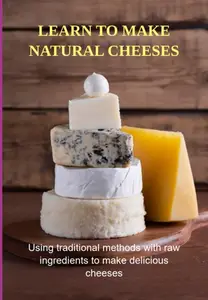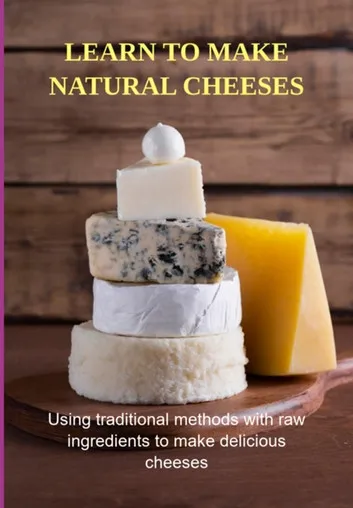Learn To Make Natural Cheeses
by Jideon F Marques
English | July 24, 2024 | ISBN: 9090008233 | 320 Pages | epub | 6,94 MB
by Jideon F Marques
English | July 24, 2024 | ISBN: 9090008233 | 320 Pages | epub | 6,94 MB
Introduction Cheesemaking, as practiced in North America, is decidedly unnatural. Is there an approach to the art that’s not dependent on packaged mesophilic starter cultures, freeze-dried fungal spores, microbial rennet, and calcium chloride? Do cheesemakers really need pH meters, plastic cheese forms, and sanitizing solutions? Are modern technologies the only path to good cheese? What of traditional methodologies? Did cheesemakers make consistently good cheese prior to pasteurization? Did cheeses fail if they weren’t made in stainless-steel vats with pure strains of Lacto¬bacilli and triple-washed surfaces? Where are the guidebooks that teach traditional methods? Have our ancestors’ cheesemaking practices been lost to the forces of progress and commercialization? I believe that the quality and taste of cheese have declined dramatically as traditional methods have been abandoned. And that the idea—propagated by the industrial cheesemaking paradigm—that traditional ways of making cheese, with raw milk and mother cultures, make for inconsistent and poor-quality cheese is a myth. For there is wisdom in the traditional practices of cheesemakers . . . Generations upon generations of traditional cheesemakers evolved the diverse methods of making cheese while carefully practicing their art. All classes of cheese were discovered by cheesemakers long before they had a scientific understanding of the microbiological and chemical forces at play in its creation. Industry and science hijacked cheesemaking from the artisans and farmers some 150 years ago, and since then few new styles of cheese have been created; yet during that time hundreds, possibly thousands, of unique cheeses have been lost. Standard methods of cheesemaking—reliant on pasteurization, freeze-dried starters, and synthetic rennets that interfere with the ecology of cheese—are equivalent to standard practices in industrial agriculture, such as the use of hybrid seeds, chemical fertilizers, and pesticides that have overtaken traditional agriculture, and conflict with the ecology of the land. Cheese comes from the land and is one of our most celebrated foods; yet its current production methods are environmentally destructive, corporately controlled, and chemically dependent. In its eating we’re not celebrating the traditions of agriculture but rather pasteurization, stainless-steel production, biotechnology, and corporate culture. If we gave its methods of production some thought, we wouldn’t want to eat the stuff! It strikes me as absurd that there is no commonly practiced natural cheesemaking in North America. Farmers practice ecologically inspired agriculture; brewers are making beers and wines with only wild yeasts; bakers are raising breads with heirloom sourdough starters; and sauerkraut makers are fermenting their krauts with only the indigenous cultures of the cabbage. But cheesemakers are stuck in a haze of food technology, pasteurization, and freeze-dried commercial cultures, and no one even questions the standard approach. Other cheesemaking guidebooks insist that home cheesemakers adopt the industrial approach to cheese along with its tools and additives. Their advice is based on standards put in place to make industrial production more efficient, and a mass-produced product safer. But for small-scale or home-scale cheesemaking, a different approach can work. A Different Approach From the making of my very first Camembert, I knew there had to be a better way than the cheesemaking methods preached by the go-to guidebooks. I just couldn’t bring myself to buy a package of freeze-dried fungus, and my search for alternatives to commonly used cheese additives led to a series of discoveries—about the origins of culture, about the beauty of raw milk, and about the nature of cheese—that set in place the philosophies of this guidebook. Not being one to blindly follow the standard path, I set out to teach myself a traditional approach to cheesemaking. The methods I share in this book are the result of 10 years of my own experimentations and creative inquiry with milk: years of trial and error in my kitchen, rediscovering, one by one, a natural approach to making every style of cheese. I now practice a cheesemaking inspired by the principles of ecology, biodynamics, and organic farming; it is a cheesemaking that’s influenced by traditional methods of fermentation through which I preserve all my other foods; and a cheesemaking that’s not in conflict with the simple and noncommercial manner in which I live my life. I now work with nature, rather than against nature, to make cheese. When I teach my methods to students, there is not a single book that I can recommend that explores a natural cheese philosophy, and no website to browse but my own. It is this absence of information in print and online that led me to write this book. I never thought that I’d be an author, but I felt compelled to provide a compilation of methods for making cheese differently. For it’s about time for a book to lay the framework for a hands-on, natural, and traditional approach to cheese. The techniques presented in this book work. And the photographs within, featuring cheeses made by these methods, are the only proof I can offer. I wish I could share my cheeses with you so that you could taste how delicious a more naturally made cheese can be, but unfortunately I cannot sell the cheeses I make because raw milk and food safety regulations restrict me from selling cheeses made in the small-scale and traditional manner that I practice. If small-scale and traditional practices are constrained by regulations controlling cheese production and access to raw milk, perhaps it is time to question the authority of these standards. We need a more radical cheesemaking, a more natural approach to the medium of milk. But it’s surprising that it’s come to me to lay this foundation; for who am I, but a small farmer and a humble cheesemaker . . .
eBook Details:
Jideon F Marques
320 Pages
7 - 8 Hours to read
99k Total words
Release Date: July 24, 2024
ISBN-13: 6569090008232
ISBN-10: 9090008233
Language: English
Format: epub
File size: 6,94 MB



